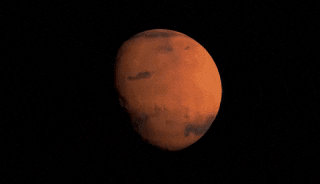

Mars

What is Mars?
Taken from the name of the Roman god of war Mars or Ares the god of war from the anciant Greek religion. It is the fourth planet in our Solar System with a mass of 639 trilliard tons and a diameter of 4220 miles (6791.432 kilometers), it is also home to the tallest mountain in the solar system.
Why is Mars a not living planet?
This is because Mars can't support life anymore. Combined with its lack of a magnetic field, left the atmosphere vulnerable to solar wind pressure (the constant stream of particles from the Sun) and too cold to support liquid water on the surface. Evidence also suggests that some or maybe even most of the water that was existing before mars' magnetic field loss is now bound in the crust of the planet, trapped in minerals.
Morphology
Geomorphology
Planet Mars ranks second smallest in terms of size in our Solar System whose diameter is about 6,791.432 kilometers (4,220 miles) and has a surfacce dimension of 144,901,401.473 km² (55,946,743.70192452 miles²).
Anatomy
It is composed of a dense metallic core overlain by less dense materials, just as Earth has. Its interior is predicted to consist primarily of iron and nickel with about 16-17% sulfur, according to current models. There are twice as many lighter elements in the iron (II) sulfide core as on Earth. In addition, Mars has a density of 3.93 g/cm³.
Tectonic plates
Location
Mars is approximately 1.5 astronomical units or 228,526,848 kilometers (142 million miles) from the Sun (its hosting star) and and is distanced from Earth by about 0.22 astronomical units or by 54,6 million kilometers (33,9 million miles).
Physico-chemical properties
Iron, oxygen, silicon, and magnesium constitute the majority of Mars' mass, with the remainder consisting of trace amounts of other elements. It is estimated that the core region contains iron, nickel, and sulfur.
Temperature
It is predicted that the mixture would remain liquid at temperatures around 1500 Kelvin (1226.85°C, 2240,33°F), which are expected to exist in the Martian core. The researchers compressed iron, nickel, and sulphur mixtures using diamond chambers until they reached the pressure expected in Mars' core, which is 40 gigapascals (400,000 times the pressure of Earth's atmosphere).
Age
Mars' age is about 4,603,000,000 terrestrial year.
Force fields

Gravitational force
Due to its smaller mass, it has a weaker gravitational pull than Earth. Mars has a gravitational acceleration of 3.72076 m/s² (about 38% of Earth's).

Magnetic field
It is reasonable to assume that Mars, as a rocky planet like Earth, operates according to the same magnetic paradigm. Aside from a few patches of magnetized crust, Mars does not produce its own magnetic field.
Motions

Orbit
The semimajor axis of Mars' orbit is 1.524 astronomical units (228 million kilometers), and its eccentricity is 0.0934. In orbiting the Sun, the planet moves 9.55 AU per day, making its average speed 24 km/s. That means it takes 687 days to fulfill a year.
Rotation
Mars completes one rotation every 24.6 hours, which is very similar to our own day, which lasts 23.9 hours. Sols on Mars are short for "solar day" which are its days.
Satellite systems

Moon system
Its moons are among the smallest in the solar system. Phobos (one of the moons) is a little larger than Deimos (the other moon) and orbits about 6,000 kilometers above the Martian surface. Like Earth's Moon, Phobos and Deimos are lumpy, heavily cratered, and covered in loose dust and rocks.
Ring system
According to researchers from SETI Institute and Purdue University, Mars had rings a few billion years ago, which is an explanation of why the moon Deimos has an oddly tilted orbit. In the future, Mars may also have rings based on that assumption.

Author: William Homier
Editor: William Homier
This page was last edited on 11 April 2022, at 19:50 (HAE).
Sources:

